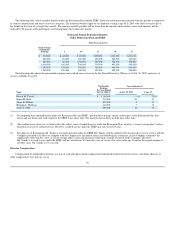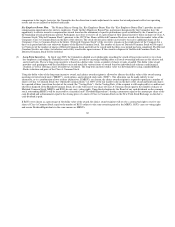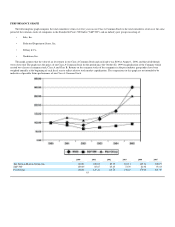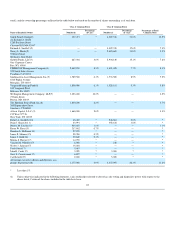Neiman Marcus 2004 Annual Report Download - page 62
Download and view the complete annual report
Please find page 62 of the 2004 Neiman Marcus annual report below. You can navigate through the pages in the report by either clicking on the pages listed below, or by using the keyword search tool below to find specific information within the annual report.
Compensation Philosophy and Objectives
We are committed to creating long-term shareholder value. The Committee believes that the compensation program for executives should be designed to
attract and retain executives who possess the high-quality skills and talent necessary to operate our business at a high level of efficiency and effectiveness.
The compensation philosophy seeks to provide a strong link between an executive's total earnings opportunity and our short-term and long-term performance
based on the achievement of predetermined financial targets and operational goals. The core principles underlying the framework for the program are:
Competitive Compensation Opportunities. The value will be based on survey information from recognized compensation consulting firms and
will be targeted at levels that will attract, motivate, and retain a highly skilled work force and enable the Company to compete for the best talent.
Performance-Based Pay. A significant part of each executive's compensation is directly linked to accomplishing specific results that will create
shareholder value in the short and long term.
Equity-Based Compensation. The Committee believes that an equity stake effectively aligns employee and shareholder interests and provides
proper motivation for enhancing shareholder value.
Executive Compensation Components and Practices
Our executive compensation program consists of three key components: (1) base salary; (2) short-term incentives (annual bonus); and (3) long-term
incentives (stock options, restricted stock and restricted stock units, purchased restricted stock and purchased restricted stock units, and matching restricted
stock units). The policies and practices for determining executive compensation and specifically that of the Chief Executive Officer, Burton M. Tansky, are
described below:
Base Salary. Base salary for each of the executive officer positions is determined with reference both to (i) salary survey information from
recognized compensation consulting firms, and (ii) other factors such as job responsibilities and scope, level of expertise and experience
required, strategic impact of the position, overall business performance, and individual contributions. The salary survey information is used to
establish benchmark amounts for both base salary and total cash compensation for each executive position. Comparisons are made to a broad
range of domestic, publicly held retailing companies, including "upscale" specialty retailing companies. Because we compete for executive talent
with a broad range of companies, the Committee does not limit its comparison information for compensation purposes to the companies
comprising the peer group in the stock performance graph included in this Annual Report on Form 10-K.
While the Committee uses the benchmarks described above as a reference point, a particular individual's base salary may vary from the
benchmark depending on his or her salary history, experience, individual performance, guidelines established with respect to salary increases for
the entire Company, and the subjective judgment of the Committee.
Annual Incentives. All executives are eligible to be considered for annual incentives. The annual bonus for executive officers is based on our
key financial and operational results as measured against targets for revenue, earnings (as measured by operational net income, earnings before
interest and taxes, or other metrics) and certain qualitative measures of performance. Targets for these measures are established in advance and
reviewed and approved by the Committee. The Committee also sets minimum thresholds that must be met before any awards can be paid. If that
minimum level is not achieved, no annual bonuses are paid. The final award amount depends on the actual level of performance achieved in
59
•
•
•
(1)
(2)
























